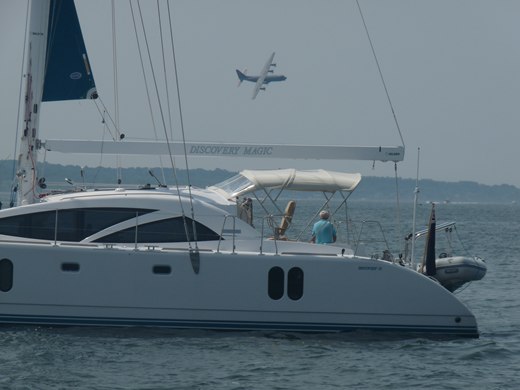We’ve spent the last two weeks in and around
the Narragansett Bay (Newport R.I.) which
has some 400 miles of coastline.
Much of our time has been spent in Newport and with good reason. The charm and vibrancy of this amazing
sailing mecca hits you between the eyes.
It’s a delight to wander the orderly streets of well-preserved, coloured
clapboard houses and to soak up the genteel living of a previous age, yet at the
same time the waterfront is tightly packed with docks and wharfs, all busy
providing facilities for the vast array of boats and lively with throngs of
people enjoying the restaurants, artisan shops and boutiques. Anchored out in the harbour, just off
the New York
and Ida Lewis Yacht Clubs, we have a continuous spectacle of yachts and dinghies
sailing past.
We have yet to experience the opulence of some of the
mansions of Newport, but the colonial Trinity Church (1725) is impressive with
its original features and we greatly enjoyed seeing the work of Norman Rockwell
and Maxfield Parrish at the National Museum of American Illustration at Vernon
Court, the name of which leads me to an aside as to when the Brits started
calling the colonialists ‘American’, rather than applying it to the native
Indians, which they had been doing as early as 1578.
Back in the early 1600s religious refugees emigrating
from England to Virginia was a route to
an early death for the majority. According to Bill Bryson, between December 1606
and February 1625, Virginia received 7,289 immigrants and buried
6,040 of them. Of the 3,500 who
arrived in the three years 1619-21, 3,000 were dead at the end of the
period. But 100 years later life on
the east coast was much improved and drew large numbers of Germans, French,
Scots, Irish and black Africans. So
although no longer just an English domain, it was still nonetheless under
British rule and they were happy to show their might. In 1739, the Spanish, fed
up with the exploits of British privateers, cut off the ear of an English
smuggler named Edward Jenkins. The
Brits retaliated, thereby starting the War of Jenkins’ Ear – I bet you didn’t
study that war at school. (The commander of the fleet in the war was Edward
Vernon, whose nickname for some reason was Old Grog and it was he who introduced
the navy’s daily ration of rum and water – hence the name of the drink – grog.) Although a relatively small
affair, it was during this war that the Brits started to refer to the provincials or colonials as Americans, seeing them perhaps as an
entity in their own right.
A couple of American friends joined us last weekend to
sail the fifteen miles to the rural island of Cuttyhunk. What a contrast between the summer
warmth outbound and creeping through the thick fog on our way back to Newport! With temperatures so far as high as 38
degrees C, at least the fog provides some natural air-conditioning.
We also seem to have been busy cleaning and ‘messing
about in boats’, which is probably just as well. Having explored the delightful town of
Bristol, as it
was a nice moonlit night we thought we would seek the prime anchorage for the
Rhode Island Air Show the following day, which would also allow us to have a
lie-in. Intent on avoiding the many
lobster pots, we didn’t notice the Coast Guard pilot vessel coming up behind us
until almost the moment they were alongside with their flashing light asking
when we had last been boarded. Their mission was nominally to check our safety
equipment, but it seemed to be important to check our bilges and one of the
engine compartments. How fortunate that I had cleaned both for the first time
that morning. The two coastguards who came aboard, like all the Americans we
have had the pleasure to come in to contact with, showed us the utmost
courtesy. The automatic response to
‘Thank you’ is ‘You’re welcome’ – which I think is lovely.



